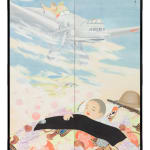Koyo Miura
Boy's Dream, mid-1930s
Two-panel folding screen; ink and colors on paper
Size 59¼ x 48¼ in. (150.5 x 122.5 cm)
T-4491
Further images
-
(View a larger image of thumbnail 1
)

-
(View a larger image of thumbnail 2
)

-
(View a larger image of thumbnail 3
)

-
(View a larger image of thumbnail 4
)

-
(View a larger image of thumbnail 5
)

-
(View a larger image of thumbnail 6
)

-
(View a larger image of thumbnail 7
)

-
(View a larger image of thumbnail 8
)

A pupil of the famous painter and teacher Kōgyō Terasaki, Kōyō Miura made his national debut at the Seventh Bunten exhibition in 1913. After traveling in Korea in 1915 and...
A pupil of the famous painter and teacher Kōgyō Terasaki, Kōyō Miura made his national debut at the Seventh Bunten exhibition in 1913. After traveling in Korea in 1915 and 1916, he submitted genre scenes from that country to the Ninth and Tenth Bunten, but at Twelfth Bunten in 1918 he reverted to a traditional Chinese figure subject. The present work is in a different style from his Bunten period, closely resembling the kimono with military motifs that were so popular at that time (for examples, see Jacqueline M. Atkins, Wearing Propaganda: Textiles on the Home Front in Japan, Great Britain, and America, Yale University Press, 2005).
Here, a small child dreams of waving flags under a Mitsubishi Ki-1, a cumbersome, poorly armored heavy bomber deployed briefly in northern China and Manchuria during the mid-1930s. Comforting domestic images (the family’s pet dog, rustic dwellings) contrast with the helmet and rifle that lie at the child’s head, perhaps the property of his father who has been conscripted into the Imperial Japanese Army. His futon (quilt) is patterned with samurai helmets and cherry blossoms, whose impermanence made them an enduring metaphor for the transitory nature of human life, especially in wartime. The painting’s somber message is belied by the artist’s choice of a range of cheerful pastel hues.
Here, a small child dreams of waving flags under a Mitsubishi Ki-1, a cumbersome, poorly armored heavy bomber deployed briefly in northern China and Manchuria during the mid-1930s. Comforting domestic images (the family’s pet dog, rustic dwellings) contrast with the helmet and rifle that lie at the child’s head, perhaps the property of his father who has been conscripted into the Imperial Japanese Army. His futon (quilt) is patterned with samurai helmets and cherry blossoms, whose impermanence made them an enduring metaphor for the transitory nature of human life, especially in wartime. The painting’s somber message is belied by the artist’s choice of a range of cheerful pastel hues.







